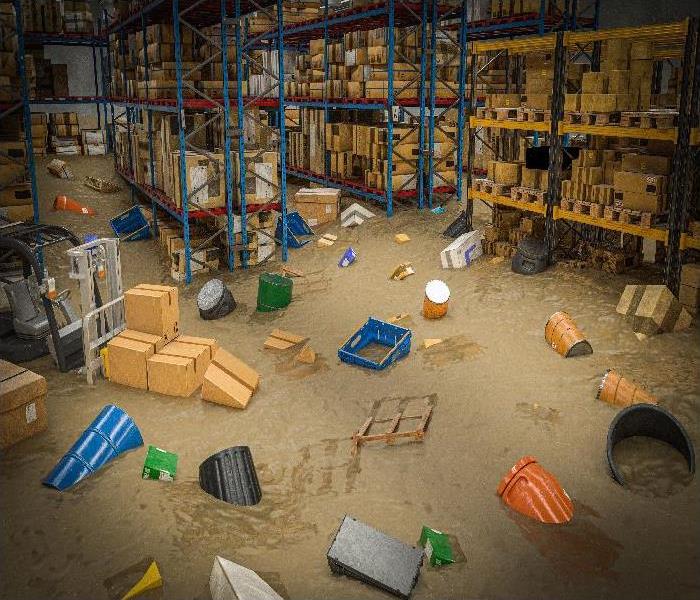Why Is Commercial Water Removal and Disinfection Responsibility Best Given to Restoration Professionals in Chicago?
5/29/2020 (Permalink)
 SERVPRO of West Loop / Bucktown / Greektown is ready to take on the most complex commercial water removal challenge.
SERVPRO of West Loop / Bucktown / Greektown is ready to take on the most complex commercial water removal challenge.
Trained and Experienced SERVPRO Technicians Are Knowledgeable, Capable, and Well-Equipped for Safe Chicago Commercial Water Removal and Sanitizing
The broad range of issues arising when managing a significant water loss in a large commercial space is not amenable to DIY interventions. Even if your Chicago business has a competent day to day cleaning staff or a reliable contracted janitorial service, water emergencies swiftly exceed the ability of cleaning crews to deliver optimum outcomes. Safety concerns and the need for highly specialized equipment and professional products to resolve the damage and health concerns arising from the addition of raw sewage to the contaminant list substantially changes the cleaning requirements.
What Makes a Contaminated Water Crisis Different from other Cleaning Challenges?
When heavy rains cause a sewage drainage pipe to back up and flood your industrial warehouse, safe and efficient water removal from your Chicago distribution center rises to a whole new level of complexity. Overflow from a nearby river exerts pressure on the normal waste flow, creating a severe risk of exposure to biohazards by your employees and potential destruction of inventory as the waste returns to your facility. Cleanup now requires:
• The wearing of full personal protective equipment (PPE) by technicians assigned to clear away the water and to perform testing for migration of contaminants into building cavities
• Containment of the contaminated fluid for disposal as hazardous waste following local regulations at an approved site
• Cleaning and disinfection of all surfaces in contact with the toxic mix of water, industrial waste, and fecal material
• Management of the saturation of the porous materials present in the affected area
What Does Water Mitigation and Remediation Look Like Under These Circumstances?
A comprehensive safety survey conducted by SERVPRO project managers identifies any live utility risks and demonstrable structural instability stemming from the exterior flooding:
• Power is shut down until safe to restart. Our equipment uses generators until that happens.
• Our crews prevent or divert the continual incursion of the contaminated water with barriers or ditching outside of your building.
• Solid debris is removed, and then we remove standing water with a series of submersible pumps followed by truck-mounted extraction under the skilled operation of our trained technicians.
• During water removal, ventilation enhances the movement of moist air by the opening of all passageways and doors and windows.
• EPA-registered cleaners and disinfectants would be applied via broadcast methods for a first pass to mitigate the effects of the contaminants before work crews commenced tasks.
How Do You Dry Out Vast Commercial Spaces?
Even though wide-open ventilation is used throughout the first phases of water removal and initial sanitizing, these conditions are not optimal for an open drying system to complete the job. High humidity outside during the spring and summer months, including the rainy weather that caused the initial flooding that led to the sewer backup, unreasonably slows drying.
Never fear. Our Institute of Inspection Cleaning and Restoration Certification (IICRC)-trained crews master many innovative and research-based options to improve drying outcomes. The IICRC is an international organization charged with setting standards in the restoration industry. The best practices established by the IICRC are reliable and practical, designed to carry out a wide range of restoration tasks safely.
Does Drying Work Better When You Contain Smaller WorkSpaces?
Using 1.6 mil polyethylene and temporary structures that partition the larger space into manageable drying areas, we can set up air movers and heaters to evaporate absorbed water more efficiently from structural components into the air as vapor. Dehumidifiers can clear the vapor when the spaces are reduced in area, collecting the water for appropriate disposal.
Why Is Disinfection Completed Before Structural Drying?
The foundation of structural drying is moving warm, dry air over wet surfaces. The disruption of the air movers can cause pathogens to become airborne, not a desirable result. Planning for a second disinfection or sanitization phase to occur before the placement of air movers reduces the chance of respreading hazardous residues throughout your commercial building.
What Is the Role of Air Scrubbers in Disinfection and Sanitization During Commercial Water Removal and Drying?
Since pathogens, including molds always present in typical commercial buildings and human infectious agents from the sewage, can become airborne during mitigation and remediation efforts, the use of air scrubbing technology is also part of the larger plan. The negative air pressure machinery forces the atmosphere within a containment partition through HEPA filters. Contaminants are captured in the filters, and the air passing through is exhausted to the outdoors. A HEPA filter must be 99.97% efficient against 0.3-micron oily aerosol particles at the application flow rate per the Institute for Environmental Sciences and Technology (IEST).
SERVPRO of West Loop / Bucktown / Greektown is ready to take on the most complex commercial water removal challenge. Our crews are familiar with hazardous waste management and remediation, including effective EPA-registered disinfection and sanitization strategies. Call for a professional consultation at (773) 434-9100.






 24/7 Emergency Service
24/7 Emergency Service